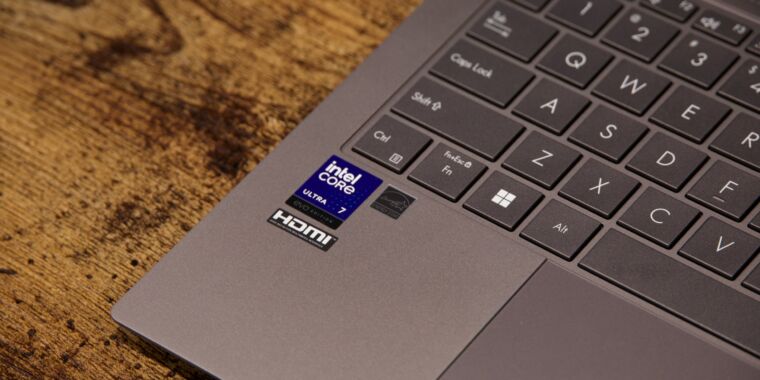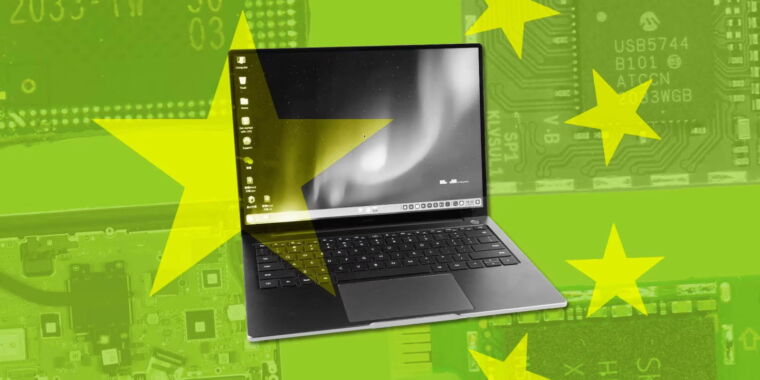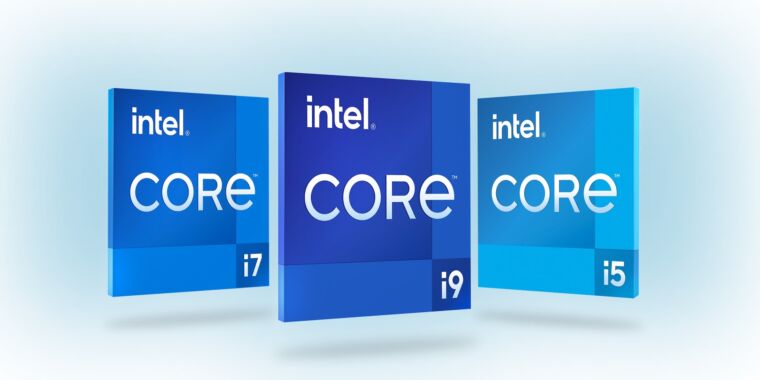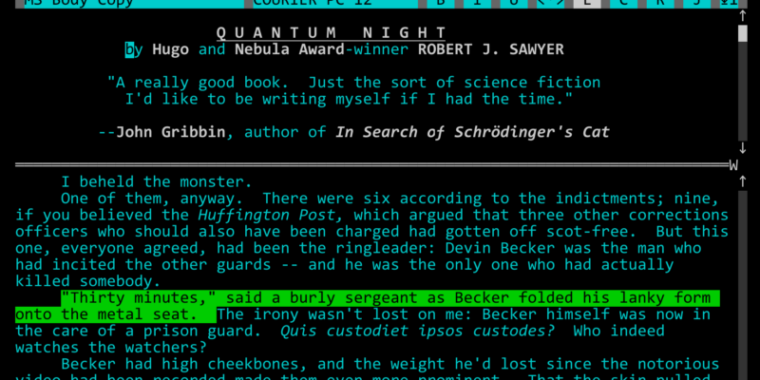Review: Intel Lunar Lake CPUs combine good battery life and x86 compatibility
-
An Asus Zenbook UX5406S with a Lunar Lake-based Core Ultra 7 258V inside.
Andrew Cunningham -
These high-end Zenbooks usually offer pretty good keyboards and trackpads, and the ones here are comfortable and reliable.
Andrew Cunningham -
An HDMI port, a pair of Thunderbolt ports, and a headphone jack.
Andrew Cunningham -
A single USB-A port on the other side of the laptop. Dongles are fine, but we still appreciate when thin-and-light laptops can fit one of these in.
Andrew Cunningham
Two things can be true for Intel’s new Core Ultra 200-series processors, codenamed Lunar Lake: They can be both impressive and embarrassing.
Impressive because they perform reasonably well, despite some regressions and inconsistencies, and because they give Intel’s battery life a much-needed boost as the company competes with new Snapdragon X Elite processors from Qualcomm and Ryzen AI chips from AMD. It will also be Intel’s first chip to meet Microsoft’s performance requirements for the Copilot+ features in Windows 11.
Embarrassing because, to get here, Intel had to use another company’s manufacturing facilities to produce a competitive chip.
Intel claims that this is a temporary arrangement, just a bump in the road as the company prepares to scale up its upcoming 18A manufacturing process so it can bring its own chip production back in-house. And maybe that’s true! But years of manufacturing misfires (and early reports of troubles with 18A) have made me reflexively skeptical of any timelines the company gives for its manufacturing operations. And Intel has outsourced some of its manufacturing at the same time it is desperately trying to get other chip designers to manufacture their products in Intel’s factories.
This is a review of Intel’s newest mobile silicon by way of an Asus Zenbook UX5406S provided by Intel, not a chronicle of Intel’s manufacturing decline and ongoing financial woes. I will mostly focus on telling you whether the chip performs well and whether you should buy it. But it’s a rare situation, where whether it’s a solid chip is not a slam-dunk win for Intel, which might factor into our overall analysis.
About Lunar Lake
Intel
Let’s talk about the composition of Lunar Lake, in brief.
Like last year’s Meteor Lake-based Core Ultra 100 chips, Lunar Lake is a collection of chiplets stitched together via Intel’s Foveros technology. In Meteor Lake, Intel used this to combine several silicon dies manufactured by different companies—Intel made the compute tile where the main CPU cores were housed, while TSMC made the tiles for graphics, I/O, and other functions.
In Lunar Lake, Intel is still using Foveros—basically, using a silicon “base tile” as an interposer that enables communication between the different chiplets—to put the chips together. But the CPU, GPU, and NPU have been reunited in a single compute tile, and I/O and other functions are all handled by the platform controller tile (sometimes called the Platform Controller Hub or PCH in previous Intel CPUs). There’s also a “filler tile” that exists only so that the end product is rectangular. Both the compute tile and the platform controller tile are made by TSMC this time around.
Intel is still splitting its CPU cores between power-efficient E-cores and high-efficiency P-cores, but core counts overall are down relative to both previous-generation Core Ultra chips and older 12th- and 13th-generation Core chips.
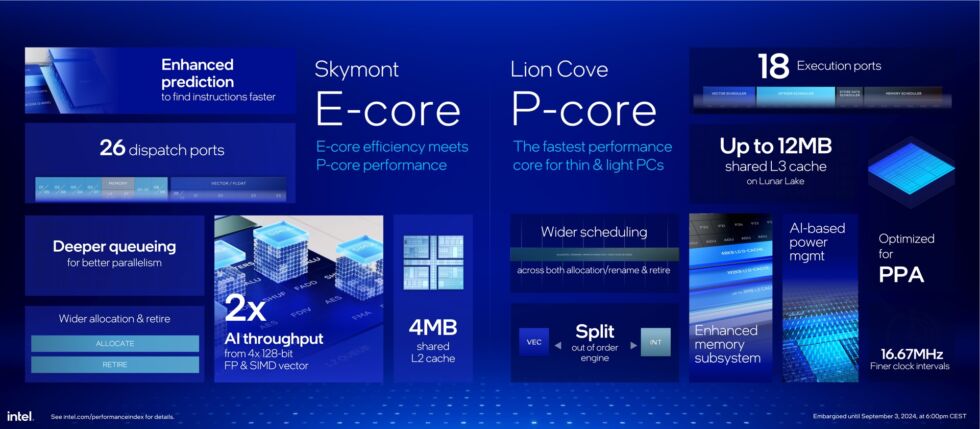
Intel
Lunar Lake has four E-cores and four P-cores, a composition common for Apple’s M-series chips but not, so far, for Intel’s. The Meteor Lake Core Ultra 7 155H, for example, included six P-cores and a total of 10 E-cores. A Core i7-1255U included two P-cores and eight E-cores. Intel has also removed Hyperthreading from the CPU architecture it’s using for its P-cores, claiming that the silicon space was better spent on improving single-core performance. You’d expect this to boost Lunar Lake’s single-core performance and hurt its multi-core performance relative to past generations, and to spoil our performance section a bit, that’s basically what happens, though not by as much as you might expect.
Intel is also shipping a new GPU architecture with Lunar Lake, codenamed Battlemage—it will also power the next wave of dedicated desktop Arc GPUs, when and if we get them (Intel hasn’t said anything on that front, but it’s canceling or passing off a lot of its side projects lately). It has said that the Arc 140V integrated GPU is an average of 31 percent faster than the old Meteor Lake Arc GPU in games, and 16 percent faster than AMD’s newest Radeon 980M, though performance will vary widely based on the game. The Arc 130V GPU has one less of Intel’s Xe cores (7, instead of 8) and lower clock speeds.
The last piece of the compute puzzle is the neural processing unit (NPU), which can process some AI and machine-learning workloads locally rather than sending them to the cloud. Windows and most apps still aren’t doing much with these, but Intel does rate the Lunar Lake NPUs at between 40 and 48 trillion operations per second (TOPS) depending on the chip you’re buying, meeting or exceeding Microsoft’s 40 TOPS requirement and generally around four times faster than the NPU in Meteor Lake (11.5 TOPS).
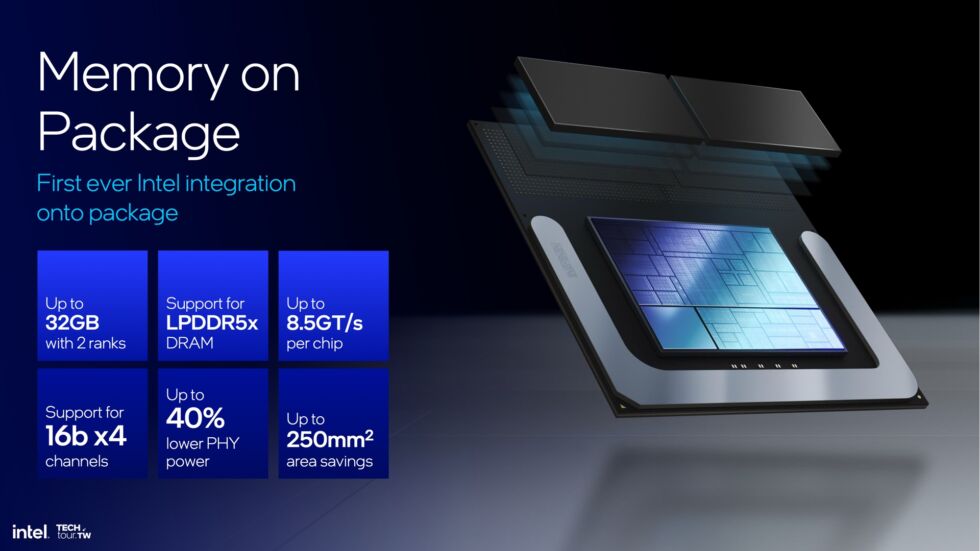
Intel
And there’s one last big change: For these particular Core Ultra chips, Intel is integrating the RAM into the CPU package, rather than letting PC makers solder it to the motherboard separately or offer DIMM slots—again, something we see in Apple Silicon chips in the Mac. Lunar Lake chips ship with either 16GB or 32GB of RAM, and most of the variants can be had with either amount (in the chips Intel has announced so far, model numbers ending in 8 have 32GB, and model numbers ending in 6 have 16GB). Packaging memory this way both saves motherboard space and, according to Intel, reduces power usage, because it shortens the physical distance that data needs to travel.
I am reasonably confident that we’ll see other Lunar Lake variants with more CPU cores and external memory—I don’t see Intel giving up on high-performance, high-margin laptop processors, and those chips will need to compete with AMD’s high-end performance and offer additional RAM. But if those chips are coming, Intel hasn’t announced them yet.

